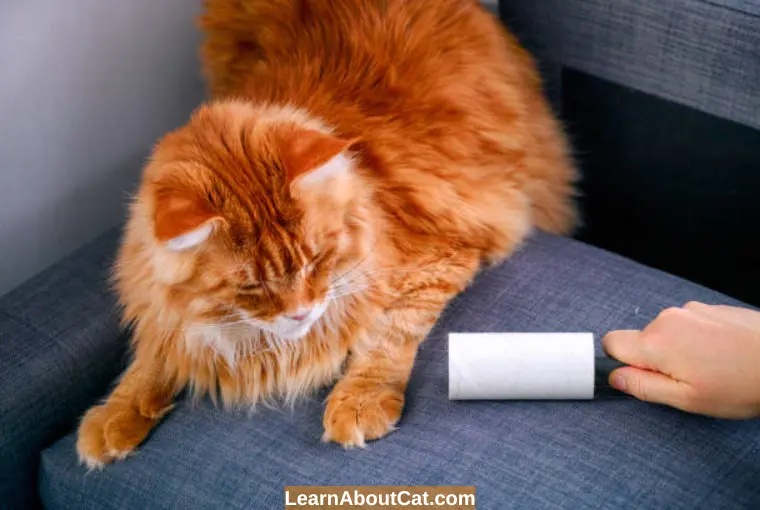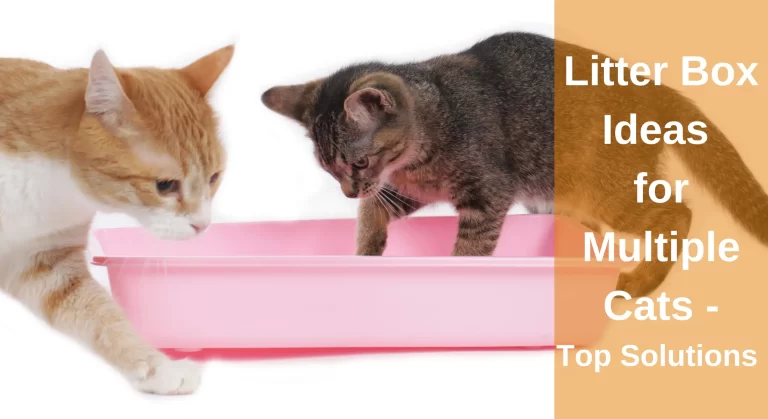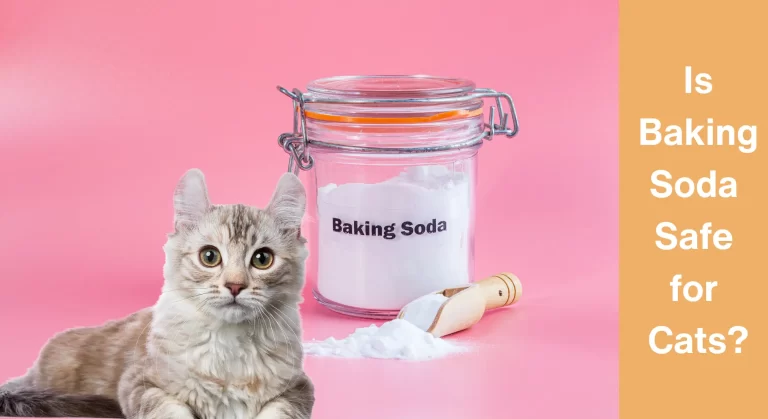Cat Losing Hair On Back Near Tail – Causes And Prevention
Our felines own our hearts, and a perfectly healthy cat has a beautiful, luxurious coat. So seeing discontinuity and patches in your cat’s perfect coat can be distressing. All cat parents are used to cat shedding, but thinning and bald patches are a whole other story. It can be unsightly and very concerning, and you may be wondering why this is happening. Why cat losing hair on back near tail?
Hair loss near the tail in cats can be caused by various factors, including flea allergy dermatitis, over-grooming due to stress or anxiety, ringworm infection, allergies, hormonal imbalances, and over-grooming from stress or anxiety.
In this article, we’ll explore the various factors that contribute to cat hair loss on their backs, common causes, diagnosis, treatment options, and preventive measures. Let’s dive in and uncover the mysteries behind this phenomenon.

What Do Bald Patches on Cats Look Like?
Bald patches on cats can have different appearances depending on the underlying cause. If your cat has bald patches, they may look like areas of the skin where there is little to no fur coverage. These patches can vary in size, ranging from small spots to larger areas.
Bald patches can manifest on any part of a cat’s body, such as the tail, neck, or ears, depending on the cause. However, it is important to note that the pattern of hair loss, rather than the specific location, serves as a key indicator of potential causes. Therefore, if you notice a bald patch, there is no particular area of the body that should immediately raise concern.
What Causes Hair Loss in Cats?
Hair loss in cats is a common issue that can be attributed to various conditions. It occurs when hair follicles, which are responsible for hair growth, became weaken or damaged. Understanding the causes of hair loss in cats is crucial for effective management and treatment.
The Role of Hair Follicles
Hair follicles are microscopic holes in your cat’s skin that serve as the foundation of hair growth. Hair grows from the root of the follicle and extends beyond the skin’s surface. Additionally, the follicles produce sebum, a natural oil that nourishes the hair and keeps it healthy.
The Hair Growth Cycle
Hair follicles follow a cyclical pattern of growth. Cats typically experience regular shedding as part of this natural cycle. Shedding occurs when hair reaches the end of its growth phase. As a result, new hairs begin to grow, repeating the cycle continuously. However, when the hair follicles sustain damage, this normal process is disrupted.
Causes of Hair Follicle Damage
Hair follicle damage can occur due to various factors, leading to hair loss and the development of bald patches. Let’s explore some common causes of hair follicle damage in cats:
- Immune System Dysfunction: In certain cases, a cat’s immune system may mistakenly identify hair follicles as foreign objects and initiate an attack on them. This autoimmune response can impair the follicles’ ability to generate new hair, resulting in hair loss.
- Trauma to the Hair Follicles: Excessive twisting or pulling of the hair within the follicles can cause the hair to become loose prematurely. This mechanical trauma weakens the follicles, leading to hair loss.
- Influence of Stress Hormones: Stress hormones can disrupt the hair growth cycle by stimulating the premature shedding of hair. Cats experiencing prolonged stress or anxiety may be more susceptible to hair loss due to hormonal imbalances.
- Inflammation from Illness or Infection: When cats suffer from illnesses or infections, their hair follicles can become inflamed. This inflammation hinders the follicles’ normal functioning, leading to hair loss.
Reasons for Cat Losing Hair On Back Near Tail
Certain illnesses and conditions cause hair follicle damage and disrupt hair growth cycles in cats. The following conditions specifically relate to cat hair loss near the tail, not overall body hair loss. Check out the possible causes and see which one matches your kitty’s situation.

1. Fleas Infestation
Fleas cause irritation and inflammation to feline’s skin by biting into it and sucking their blood. Fleas like to gather on the base of your cat’s tail, causing intense itching in that specific area. Your cat will brutally scratch itself in this area with its sharp claws, damaging the hair follicles and causing the hair to fall out.
The flea bites inflame the hair follicles, while the never-ending scratching and biting worsen the situation, leading to even more hair loss. It’s a battle your cat wants to win!
Moreover, if your cat is allergic to flea bites, it may develop flea allergic dermatitis, which makes the inflammation and itching even worse than just an ordinary flea infestation. You will notice scabs and open wounds in your feline’s coat.
If you think your cat has fleas, you will notice your pet is excessively itching, scratching, biting, and overgrooming itself. All these things cause hair to weaken and fall out.
The good news is that fleas can be eliminated through routine spot-on treatments or other preventive measures. In cases where a flea bite triggers an allergic reaction leading to baldness, a veterinarian may administer injections or other treatments (topical anti-flea medication and topical steroid cream) to reduce the allergic response and soothe the affected area. Once the inflammation resolves, the hair is expected to grow back.
Also Read: How To Get Rid of Fleas in the House? [A Complete Guide]
2. Ringworm Skin Infection
Ringworm is a type of fungal infection that manifests as raised and inflamed lesions on your cat’s skin. The fungi feed on the keratin of your cat’s back skin, which is the most common site of infection. However, ringworm skin infections can occur anywhere on your feline’s body(head, chest, front, and, legs ) and cause plenty of hair loss.
Hair loss is a direct consequence of fungal spore infection within the hair shafts and follicles. This invasion weakens the structural integrity of the hair, causing it to become fragile and eventually shed. The affected regions may exhibit complete alopecia or a distinct reduction in hair density.
Your cat is susceptible to ringworm, a fungal infection transmitted through contact with fungal spores that can linger on objects for up to two weeks. To confirm the presence of ringworm, a sample from the affected area is collected and tested in a laboratory. It is crucial to exercise caution if you suspect your cat has ringworm, as humans are also at risk of contracting the infection.
The good news is that treating ringworm in cats is relatively simple. It involves the application of topical antifungal medication to the affected areas, accompanied by the administration of a systemic drug. With consistent treatment, you can expect the infection to be completely cleared within about six weeks.
Find Out: Should I Quarantine My Cat With Tapeworms: All You Need To Know
3. Allergies
Allergies can also cause baldness in cats. If your cat is allergic to something and is exposed to the allergen, it causes a strong histamine response in its body. The resulting inflammation and redness of the skin contribute to hair loss. It also makes your feline really itchy, so it will scratch itself and over-groom, contributing to more balding.
Cats often have food allergies, and it’s usually because of the protein in their cat food. Common symptoms of food allergies include daily hairball regurgitation, post-meal vomiting, and potential diarrhea
Environmental allergies can trigger immune responses, with potential culprits like dust mites, pollen, mold, and fragrances emanating from specific cat litter. In these cases, cats may exhibit symptoms such as sneezing, coughing, and discharge from the eyes and nose.
You will need to figure out what your cat is allergic to and eliminate it. By eliminating the culprit, you should see a reduction in symptoms and an improvement in your cat’s overall condition.
4. Supracaudal Gland Hyperplasia
Supracaudal glands are sebaceous glands located at the base of your cat’s tail. These glands secrete sebum that maintains your feline’s fluffy and glossy tail. Sometimes, due to male sex hormones, they may go into overdrive resulting in a very greasy tail.
This excess oil makes the hair at the base of your cat’s tail greasy. Moreover, the sebum can obstruct the pores present in the cat’s skin, leading to hair loss in that specific area. The region surrounding the supracaudal gland becomes more susceptible to infections, exacerbating hair thinning and the development of bald patches.
This condition is most commonly seen in male, non-neutered cats, so it is sometimes referred to as “stud tail”. It is very rare in neutered or female cats but it is possible. If you think this is the case, neutering your cat can solve the problem because the issue is basically a hormone overdrive. You can also try anti-seborrheic shampoos to clear out the excess sebum and deal with the problem.
5. Overgrooming from Stress or Anxiety (Psychogenic Alopecia)
When cats are stressed or depressed, they groom themselves excessively as a way to comfort themselves. They do this on their legs, their lower back, and their stomach. This overgrooming pulls at the hair, breaking them prematurely and causing baldness.
Cats need consistency and familiarity in their lives to stay grounded. The slightest change in their everyday routine can throw them out of whack. Cats shed excessively when going through something difficult.
Psychogenic alopecia, unlike stress-related shedding, is a specific type of hair loss that occurs as a consequence of excessive grooming by cats. When felines feel stressed or anxious, they engage in grooming behavior, which serves as a therapeutic mechanism to soothe their troubled minds when faced with fear or distressing situations.
Apart from the visible signs of over-grooming and balding, closely monitor your cat’s behavior to identify other manifestations of extreme stress, anxiety, or depression. The following behaviors may serve as valuable insights into their emotional state:
- Hiding & Acting Weird
- Hissing or growling/aggressive behavior
- Scratching objects and furniture
- Loss of appetite
- Soiling other areas of the house
- Sleeping more than normal
6. Urinary Tract Disease
Urinary tract infections (UTIs) are common in cats. Most cats contract a UTI at least once in their lives. If your cat has a UTI, it will experience extreme pain while peeing.
So you will notice your cat going to the litter box frequently or spending a lot of time there trying to pee, only to be able to pass a few drops out. Your cat will also vocalize its pain. In rare cases, you might notice blood along with its urine.
The pain and discomfort that UTIs cause make your cat overgroom that area in an attempt to relieve itself. However, cats have rough tongues with tiny hook-like structures. The hair catches onto these structures and is pulled out of their follicles, causing balding in that area.
7. Arthritis
Arthritis: the silent tormentor of our feline companions. If your cat experiences fur loss on their back legs rather than their tail, it could potentially be attributed to arthritis. Similar to urinary disorders, causes cats pain and discomfort.
Feline Arthritis is the breakdown of your cat’s joints(Inflammatory joint disease). It occurs in elderly and obese cats and results in a lot of joint pain.
Grooming serves as a vital coping mechanism for cats enduring pain Because these cats are not mobile, making it difficult to groom their entire bodies. Instead, they tend to over-groom one particular area of their body that is easy to reach. That area receives the brunt of your cat’s rough tongue, resulting in regional alopecia.
Your cat will exhibit other signs as well, such as:
- Stiffer and slower movements
- Less moving around
- Does not jump or climb stairs
- Aggression when painful areas are touched
8. Other Painful Medical Conditions
Additional medical conditions can also cause cats pain, leading to overgrooming and resulting in fur loss on their back legs, the base of the tail, or elsewhere on their body.
- Cat bite abscesses: Often arise from territorial disputes with other felines. These wounds, if left untreated, can become severely infected, exacerbating the hair loss issue.
- Hereditary genetic conditions: Which lack a definitive cure, can trigger hair loss in cats, although in most cases, the hair does tend to grow back eventually.
- Medication side effects: Certain medications prescribed for unrelated ailments may inadvertently result in hair loss as a side effect.
- Leukemia’s lurking: It can manifest as an independent cause of hair loss in cats, or it may arise as a secondary effect resulting from the prescribed medication.
- Skin injuries and scarring: When cats graze or cut their skin due to accidents or mishaps, hair regrowth may be hindered in the scarred areas.
Symptoms of Bald Patches on Cats
Hair loss on the back near the tail is the primary symptom of concern. Additionally, you may observe the following signs:
- Redness or inflammation or sores on the affected skin
- Itching or scratching
- Dry, flaky, or scaly skin
- Presence of fleas or flea dirt
- Circular patches of hair loss
- Scaling or flaking of the skin
- Scabbing of the skin
- Weakness and lethargy
- Vomiting
- Loss of appetite
How to Prevent Hair Loss in Cats?
Generally speaking, cats start growing back their coat after the underlying cause has been treated. If you notice bald spots at the base of your cat’s tail or on any other part of its body, it’s best to visit the vet. The following are some things you can do to maintain your fur ball’s luxurious coat:

Find Out: Why Does My Cat Have Bald Spots And Sores?
1. Routine
Try not to disrupt anything about your feline’s environment, food, or routine. If you need to switch its food, do it gradually by mixing it with its old food. If you recently got a new pet, slowly introduce the new addition for a short period of time every day.
Make sure there is nothing in your cat’s surroundings that can be causing it stress. A happy cat equals a fluffy cat!
2. Adequate Diet
Your cat needs sufficient amounts of protein in its diet, so there are better ideas than budgeting in that area. Low-quality kibble contains very low protein and has mostly carbohydrate fillers.
Your cat needs all essential macro and micronutrients to maintain a healthy and luxurious coat, so opt for high-quality cat food. Also, if your cat is allergic to a specific brand or type of food, keep your feline away from it, as food allergies also lead to hair loss.
3. Regular Flea Treatment
Flea infestations are the most common reason for hair loss in felines, especially the on the back near the tail. Applying topical anti-fleas cream on your cat’s skin monthly can prevent fleas from inhabiting your cat’s coat altogether. Stay away from flea collars, though as they contain dangerous insecticides which are harmful to cats.
4. Keep Allergens at bay
Keeping your cat away from allergens can prevent the inflammatory reaction that causes itching, irritation, and, eventually, hair loss. If your cat is allergic to dust, you can think about investing in an air purifier. Keep your cat inside if it is allergic to pollen.
Will My Cat’s Hair Grow Back?
In most cases yes. The possibility of hair regrowth on a cat’s back near the tail is closely linked to the accurate identification and successful treatment of the underlying cause. While the exact duration for regrowth varies among cats, it typically ranges from a few weeks to several months.
Shorthaired felines often experience a relatively faster regrowth rate, with visible hair returning within weeks.
However, other cats, depending on factors such as their overall health and the specific cause of hair loss, may require a longer period of several months for noticeable regrowth to occur.
Frequently Asked Question
Why is my cat losing hair on his hindquarters?
Hair loss on a cat’s hindquarters can have various causes, including allergies, flea infestation, over-grooming due to stress, hormonal imbalances, or skin infections. A veterinary examination is recommended to determine the specific cause and appropriate treatment for your cat’s hair loss.
Are there any home remedies for treating bald patches on cats?
Don’t risk your cat’s well-being with unproven home remedies! Despite claims, coconut oil, aloe vera, oatmeal bath, and baking soda paste lack scientific evidence in treating bald patches on cats. For proper diagnosis and treatment, it’s recommended to take your cat to a vet.
Is it normal for a cat to have some hair loss around the tail?
Some minimal hair loss around the tail can be considered normal due to regular grooming. However, if the hair loss is excessive, accompanied by other symptoms such as itching, scratching, vomiting, throwing hairballs, or affecting the cat’s well-being, it’s advisable to consult a veterinarian for further evaluation.
Conclusion
Bald patches on cats can be a cause for concern, but they are often indicative of an underlying issue that can be addressed with proper veterinary care. There are several health conditions that cause felines to lose hair on the back near their tail, including fleas, allergies, urinary tract infections, or fungal infections.
Your cat can also be overgrooming out of stress, causing hair loss. Identifying the underlying cause is essential for proper treatment and management.
If you notice bald patches on your cat, you should take it to the vet. The vet will diagnose the underlying cause and prescribe a treatment, so your cat will be healthy and perfect in no time!
Related Posts:
Who is Isabella?
My name is Isabella, and I am a dedicated and knowledgeable cat enthusiast. With years of experience caring for cats and a deep love for felines, I made a mission to help other cat lovers navigate the challenges of cat ownership.






